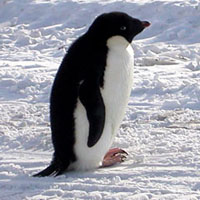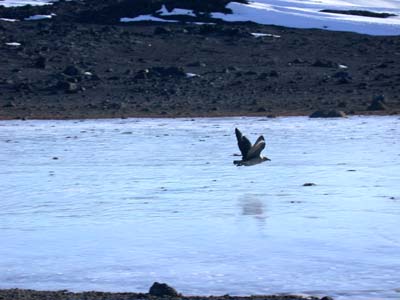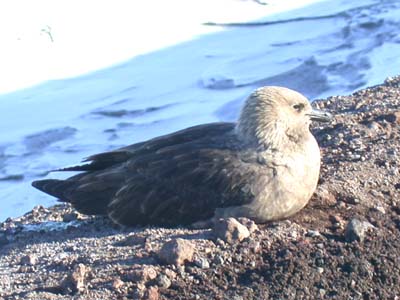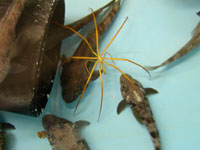TIGER in Antarctica
Wildlife
I've now got my Adelie Penguin sighting. Now all I need is Emperor Penguins (much rarer here in McMurdo).
 Adelie Penguins are the smaller and more common type of penguin seen in McMurdo. We saw this one right by Scott Base (the New Zealand Station) as
we were driving to Willy Field. A full description of the sighting is at the A Penguin! web page.
Adelie Penguins are the smaller and more common type of penguin seen in McMurdo. We saw this one right by Scott Base (the New Zealand Station) as
we were driving to Willy Field. A full description of the sighting is at the A Penguin! web page.


 South Polar Skuas are the most common wildlife at McMurdo. They are large seagulls, and the ones in McMurdo have grown quite accustomed to human presence. If you move slowly, you can walk right up to them. There aren't flocks of them, but there are usually one or two around town. The flying skua picture is from Cape Evans by Scott's Hut. Both of these pictures were taken in 2001.
South Polar Skuas are the most common wildlife at McMurdo. They are large seagulls, and the ones in McMurdo have grown quite accustomed to human presence. If you move slowly, you can walk right up to them. There aren't flocks of them, but there are usually one or two around town. The flying skua picture is from Cape Evans by Scott's Hut. Both of these pictures were taken in 2001.
 Weddell seals are the most common type of seal in McMurdo Sound. This one was resting on the ice shelf right outside of town in November 2003. Since it was right next to one of the flagged hiking and cross country skiing trails (called Armitage Loop which curves around to coast to Scott Base, the New Zealand station), I was able to get close (but not too close) to it.
Weddell seals are the most common type of seal in McMurdo Sound. This one was resting on the ice shelf right outside of town in November 2003. Since it was right next to one of the flagged hiking and cross country skiing trails (called Armitage Loop which curves around to coast to Scott Base, the New Zealand station), I was able to get close (but not too close) to it.
 There are several research sites for seals, but they don't like other people to bother their test subjects. In 2001, we saw these seals near the Ice Caves on the Erebus Glacier Ice Tongue. There was a research station nearby and we weren't allowed to stop the vehicle. But I took this picture hanging out the window while moving. They were a distance away, and mostly looked like big slugs hanging out on the ice.
There are several research sites for seals, but they don't like other people to bother their test subjects. In 2001, we saw these seals near the Ice Caves on the Erebus Glacier Ice Tongue. There was a research station nearby and we weren't allowed to stop the vehicle. But I took this picture hanging out the window while moving. They were a distance away, and mostly looked like big slugs hanging out on the ice.
 Sea Spiders are a crustacean that can be found off the coast of the US. However, they are typically dime sized in the US, here they get up to 12 inches across. This one (in a holding tank at the aquarium at Crary Lab), was about 8 inches across.
Sea Spiders are a crustacean that can be found off the coast of the US. However, they are typically dime sized in the US, here they get up to 12 inches across. This one (in a holding tank at the aquarium at Crary Lab), was about 8 inches across.

Dr. Eric R. Christian
Eric's Featured Scientist Profile
This page was last modified on November 23,
2003
|
|
|